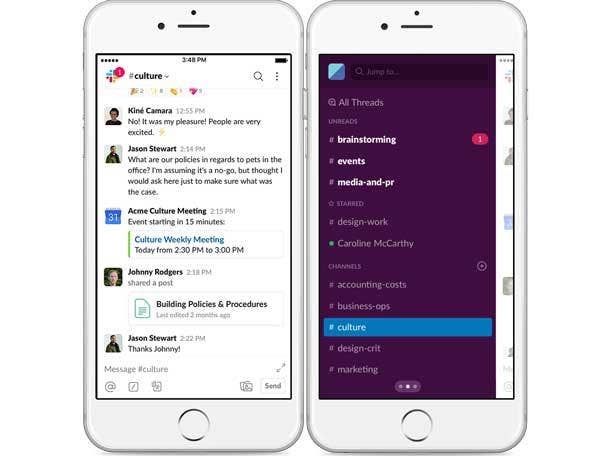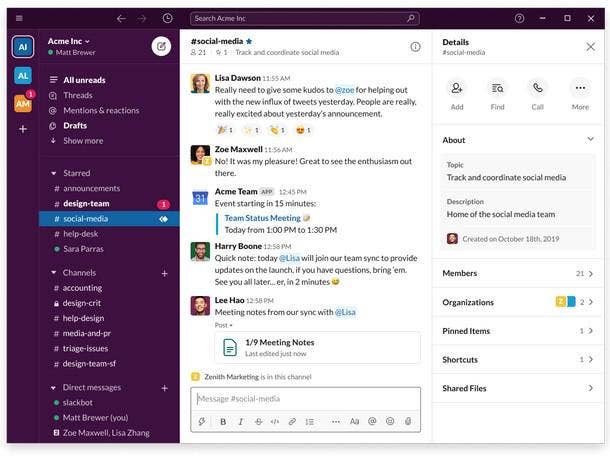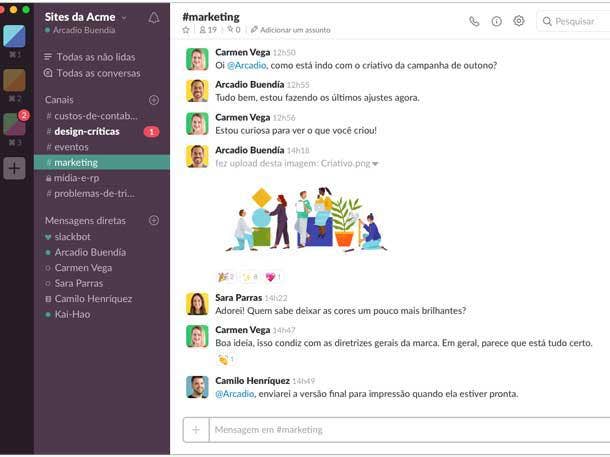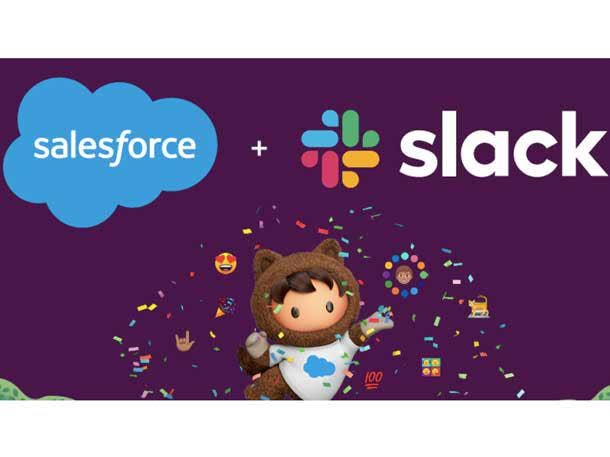Dreamforce 2022: Slack Channel Chief Foresees App In Every Salesforce SI’s Solution
“It’s fair to say over the next 18 months every SI (systems integrator) and ISV (independent software vendor) solution will have Slack as a part of it,” Slack channel chief Richard Hasslacher tells CRN in an interview.

More than a year after the close of Salesforce’s $27.7 billion acquisition of collaboration application Slack, Slack channel chief Richard Hasslacher and his team have been at work helping the subsidiary’s earliest partners gain certifications and develop industry-focused services to bring to market.
His prediction is that Slack will be part of every solution from Salesforce system integrators (SIs), Hasslacher – whose formal title is Slack’s vice president of global alliances and channels – told CRN in an interview.
“It’s fair to say over the next 18 months every SI (systems integrator) and ISV (independent software vendor) solution will have Slack as a part of it,” Hasslacher said. “That’s the way the market is going, whether it’s Slack or something like Slack, this is the future of how customers want to and need to engage with technology and also enable that digital-first style of working.”
[RELATED: Salesforce-Owned Slack Grows Partner Program]
On Thursday, Slack and Salesforce named in an online post some partners who have introduced to market industry-focused services that feature Slack.
The partners include Accenture, Atrium, Capgemini, Deloitte, IBM, KPMG, NeuraFlash, PwC, Silverline and Slalom, according to the company. Their industry-focused services are meant to appeal to financial services, manufacturing, communications, retail, media, technology and other verticals.
The announcement came ahead of Salesforce’s annual Dreamforce conference, which runs from Tuesday to Thursday.
As an example of the industry-focused Slack services, Bozeman, Mont.-based Atrium has a joint Tableau-Slack offering aimed at wealth and asset management firms, where coworkers can share account data and insights using Slack. Tableau is another Salesforce subsidiary, along with integration vendor MuleSoft.
In a recent interview with CRN, Atrium CEO Chris Heineken said that data visualization has been a starting conversation that leads into more sales around predictive analytics, data infrastructure and data strategy.
Heineken praised Salesforce’s partner organization – which now includes Hasslacher and his team of about 20.
“They’ve done a tremendous job supporting the ecosystem,” Heineken said.
Hasslacher said that partners remain an important part of both Slack’s and San Francisco-based front-office software vendor Salesforce’s go-to-market strategy.
“There’s a number of macro-industry trends that are impacting knowledge workers,” Hasslacher said. “Things like … a continuously proliferating set of applications … the ongoing consumerization of IT and what that user experience feels like, the shift from in-office to hybrid and fully distributed. And some companies have formed an opinion. Other companies are still scrambling to figure out what that means for them. And they’re really looking to their consulting and strategy partners to help them understand, internalize the trends that matter to them and their industry.”
Here’s what else Hasslacher had to say to CRN.

How is the development of Slack’s partner ecosystem going?
It’s been over a year now since the acquisition (by Salesforce) closed and there’s been a lot of investment in maturing the co-selling between our respective sales organizations. It offers us a huge opportunity to bring Slack into a lot of mature Salesforce customers who need Slack or something like Slack.
Our product teams have done a phenomenal job in creating integrated experiences between Slack and the core Salesforce offerings. And that leads into helping customers understand the art of the possible with Slack. … So I feel like that’s maturing really well. How this relates to partners … we’ve been doubling down on a specific subset of that ecosystem to really help them hone their skills on Slack.
And that was the initial announcement – onboarding those initial partners. … And we’ve been working with them not only to build out their capabilities and capacity around getting certified, so they’re starting to really build their bench of certifications, but also helping them to develop their first set of solutions.
Initially, we’ve been focusing them on building LOB (line of business) solutions, focusing on sales, service, because ultimately that’s where the momentum was going.
Post-launch was like, ‘How do we create an integrated experience with Sales Cloud? How do we create an integrated experience with Service Cloud?’ That’s where our product marketing was most robust. So when we think about leveraging and repurposing the assets that we use for customers to then educate partners, that’s naturally where we gravitated toward.
But as part of our overall maturity of selling with and co-selling with the Salesforce sellers, Salesforce is heavily aligned to industry OUs (operating units) … So in an effort to do that, we pivoted our selling to be industry focused. And that has offered up a phenomenal opportunity for our partners because … that’s how our partners think. They align to industry. They have deep industry expertise. And in many ways, they are far more credible than most vendors at talking industry.

Why are partners important for go-to-market?
The digital HQ (headquarters) for a specific customer really depends on what industry they’re in, what stage of maturity they’re at, what size they are, what geography they are in. And the digital HQ in its simplest form comprises two major components. One is best-in-class technology, which is Slack and the Salesforce Customer 360.
The other major components are those ancillary services that bring it to life. So let’s start with advisory, for example. There’s a number of macro-industry trends that are impacting knowledge workers. Things like … a continuously proliferating set of applications … the ongoing consumerization of IT and what that user experience feels like, the shift from in-office to hybrid and fully distributed.
And some companies have formed an opinion. Other companies are still scrambling to figure out what that means for them. And they’re really looking to their consulting and strategy partners to help them understand, internalize the trends that matter to them and their industry.
So there’s an opportunity for advisory. There’s an opportunity for strategy – once they understand those macro trends, they need a strategy partner to help figure out, ‘What’s the roadmap that we need to put in place to navigate those?’
And then there’s, ‘OK, what are the tools that are the catalysts to help us make that change?’ And that’s really where Slack and Salesforce technology come into play.
And then ultimately, what’s the right change management methodology to ensure that we’re being really thoughtful about how we bring these changes in? So, deep needs analysis, business process reengineering, and the right stakeholder buy-in and training to ensure long-term adoption.

What are you seeing in your partners’ solutions?
When we talk about the investments that partners are making, a lot of those practices are not specific to Slack, but they are critical to bringing the digital HQ to light. … It’s fair to say over the next 18 months every SI (systems integrator) and ISV (independent software vendor) solution will have Slack as a part of it.
That’s the way the market is going, whether it’s Slack or something like Slack, this is the future of how customers want to and need to engage with technology and also enable that digital-first style of working.
We’re taking a very deliberate approach in the beginning to double down on those partners shows who have shown an appetite to invest in these emerging services opportunities and who have established relationships with the sellers and the CS (customer success) teams. …
We’re already identifying the next wave of partners to double down on and then looking to scale this to the whole ecosystem.
Invariably, there’s different phases of adoption within the ecosystem. Partners have different priorities. Some will specialize in certain clouds, or they will have a full portfolio.
Some will be innovators and want to be ahead of the crowd. Others will be fast followers, and others will be more laggards and wait for the market to really mature before they get in.
These are the partners that have seen value in being innovators – by getting ahead of the curve, by establishing their reputation as thought leaders when it comes to helping customers form an opinion on Salesforce’s latest wave of innovation.
This will really come out at Dreamforce as well. Slack is going to be front and center. These partners get to talk about the investments that they’re making, and really elevate themselves as thought leaders when it comes to helping customers embrace this new digital HQ.

What’s been tough about building a partner ecosystem?
The biggest challenge we have, if that’s the right word to use, is working with partners to help them understand that now is the right time to invest.
And we’ve been working diligently, not just in helping them build their solutions and have the right value narrative around Slack, but also working with them in the field. Really digging into accounts. They have some fantastic relationships at the customer level. So do we.
We connect at different levels in the business. They’re always looking to be relevant to their customers and making sure that they’re bringing the next wave of innovation, especially to those customers who have made such a big investment in Salesforce’s Customer 360. … One of the things that I’m really proud of with the team is we’ve managed to get global coverage from our partners. … The U.S., Latin America, Asia Pacific and EMEA (Europe, the MIddle East, Africa).
Also, when we look at the size of partners, so we’ve got the Accentures, the Deloittes, the IBMs of the world. But then we’ve got the Silverlines, and we’ve got the Atriums and the NeuraFlashes and the Slaloms in between all that.
So I think we’ve got a really nice spread of partner size that will be relevant to different types and sizes of companies. And we’ve got a nice geographic spread. … And also we’ve got a really nice spread of industry coverage. … And over time, we’ll expand that portfolio to include all clouds, all industry sectors, and scale it to the whole ecosystem.

Can Slack attract new partners to the Salesforce ecosystem?
Existing partners will definitely increase their overall investment because of Slack. But I do think we have the opportunity to bring more partners into the ecosystem.
There’s been a number of boutique (consultancies) that have emerged since 2014, 2015 that are addressing a need in the market where customers are being a lot more thoughtful about their human capital management. Being a lot more thoughtful about change management, being a lot more thoughtful about the role that technology plays.
So I think that typically the (larger consultancies) have really focused on the upper end of the market. I think the midmarket is getting a lot more thoughtful around this now as well. … So I can see them coming into the fore over time.
Slack being that agent of change is something that we’re really trying to solidify in the market. And that’s starting to happen. And for that reason, I think we’ll see these smaller consultancies, who are very much focused on human capital management … come into play. And that would be cool.
For us, it’s all about serving the customer, and what they need. And Slack fills a role from a technology perspective. But customers need the support to navigate how to use it to its greatest effect. And I think that really will dictate where we go looking for new partners.
We’re always looking for new partners from a capacity perspective. But the question is, will the maturation of the go-to-market with Slack mean that we need a slightly different profile of partner. And that question is more TBD (to be determined) right now. … And that’s why I’m glad that there’s that representation in the size of the partners.

Salesforce channel chief Tyler Prince
What’s your advice to partners to get more out of their Slack and Salesforce relationship?
Continue to deepen their understanding of how Slack fits into the Customer 360. We are the producers of the products and we’ve got a strong perspective for the value that they generically should provide.
But the partners will understand to a deeper degree on the industry side. And they’re also connected at the business objective level, which really gives them a rich understanding of where Slack can be leveraged as that agent of change.
My advice would be don’t wait for the market to come to you. Bring it to the market. And obviously that benefits us as the vendo. But customers are waiting for this.
They are not quite sure exactly what they need. And they’re looking for that guidance to figure out how they adapt to this new way of working. … Lean in. Form a perspective. Don’t wait for the market to come to you.
How does Slack’s channel organization fit into Salesforce’s organization?
We’re now part of (Salesforce Executive Vice President of Worldwide Alliances and Channels) Tyler (Prince)’s organization. … And we are now a team of however many, 1,500 people that Tyler has.
When I talked about Slack being a component of every ISV and every SI solution in the next 18 months, that’s a big part of our focus. How do we actually not just enable key partners, but also how do we enable the broader alliance organization to bring this to market?
As we move into FY ’24 (fiscal year 2024 – Salesforce’s fiscal year starts Feb. 1), that’s a big focus for me, is to figure out, what is our optimum working model. … We think and breathe Slack every single day, whereas our counterparts on the core side, as we call them, they are thinking across the full portfolio of products. … Some in the alliance organization think in (terms of) industries, some of them think in (terms of) certain partners.
But they all think across multiple products, whereas we think about Slack and how that integrates with other products that the partners are building on top of. … As a team, we’re 20 people. We have people all over the world. And we are really focusing on, not just the first wave of partners, but also figuring out how we can enable the broader alliances organization to work with partners more broadly to bring this innovation. And that’s just part of the overall integration journey that we’re on right now. … It definitely helps that I spent nine years at Salesforce prior to getting acquired.
So there’s a level of understanding among me and my peers. And I think we speak the same language. I think one of the opportunities is we’re doing a lot as a company.
So how do we be thoughtful about how we start to deepen the broader organization’s understanding of Slack and find that balance of getting them educated to the degree where they can bring this to the partners without expecting them to be Slack experts?

Are you growing the partner team?
We’re going through planning for FY ’24 as we speak. We definitely plan on investing in the team.
We’re looking to optimize the resources that we have currently, which is no surprise for a company of 80,000 people.
But the areas where we’ll continue to invest in is partner success, solution scoping – so really helping those partners figure out, what are those solutions that they need to build? What’s the right experience that they need to create?
And how do they really need to evolve their practice areas to weave Slack into that so they’re really prepared from advisory, strategy, organizational transformation and change management to fully leverage Slack as part of those practices over and above the technical competency that we’re certifying in the Salesforce practice itself.
So a lot of it is going to be around partner success and then enabling the existing partner account managers and partner sales managers to bring Slack to market.